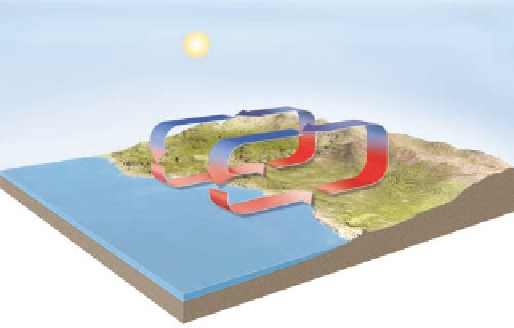Geoscience Reference
In-Depth Information
6.
The production of wind energy is rapidly growing in the
United States and around the world. Excellent places
for wind-energy production within the United States
occur within the central part of the country and along
mountain ranges in the west.
KEY CONCEPTS TO REMEMBER ABOUT
GLOBAL CIRCULATION
1.
The fundamental consequence of global air movement
is to equalize the differences in temperature and pres-
sure between the tropics and the poles.
Local Wind Systems
2.
The global circulatory system consists of a series of
separate, but connected, pressure systems that distrib-
ute air around Earth.
So far, we have examined circulatory systems and associated
wind patterns that occur over regional and global scales. On a
much smaller scale, local wind systems result from temperature
differences created by topography, proximity to large bodies of
water, or other geographic features.
3.
Tropical circulation occurs in association with convec-
tion processes in Hadley cells, forming the Intertropi-
cal Convergence Zone (ITCZ) and the Subtropical High
(STH) Pressure System. The ITCZ is a zone of low pres-
sure where the winds are easterly. In contrast, the STH
is a high-pressure system that rotates clockwise in
the Northern Hemisphere and counterclockwise in the
Southern Hemisphere.
Land-Sea Breezes
Land-sea wind systems are localized along the shores
of major water bodies, such as oceans or large lakes.
These winds form due to the different heating and cooling
characteristics of continents and water, as we discussed in
Chapter 5 (the maritime vs. continental effect). During the
day, air over land heats up more rapidly than air over water,
resulting in a small zone of low pressure that forms over the
land near the shore. Over water, in contrast, the air pressure
is relatively high because the air is cooler and denser as it
sinks. This difference sets in motion a
sea breeze
: The air
flows from the sea toward the land, that is, from high to low
pressure (Figure 6.28a).
This local circulatory pattern reverses at night because
air over the land cools more rapidly than air over the sea.
As a result, the pressure systems switch locations, with
4.
Midlatitude circulation is driven by contrasting air
temperatures on either side of the polar front. A ma-
jor feature of midlatitude circulation is the jet stream,
which consists of high-speed westerly winds that
flow along the polar front. During the summer, the
jet stream exhibits zonal flow that is confined to high
latitude. As fall approaches, the jet stream begins to
develop distinct undulations that are associated with
Rossby waves.
5.
The monsoon is a distinct circulatory feature that exists
in tropical areas where large land bodies border oceans.
Landmasses are warm relative to water in summer, re-
sulting in low pressure over land and onshore airflow.
During winter, water bodies are warm relative to land
and the winds reverse their flow direction.
Sea breeze
Daytime circulatory system along coasts where
winds flow from a zone of high pressure over water to a zone of
relatively low pressure over land.
2
Cooler air sinks
over land, causing
higher pressure
1
Heated air rises
over warmer land,
causing lower pressure
2
Cooler air sinks
over water, causing
higher pressure
L
H
H
Heated air rises
over warmer
water, causing
lower pressure
1
L
3
Cooler air flows inland
toward lower pressure
3
Air flows offshore
toward lower pressure
Lower temperature,
higher pressure
Higher temperature,
lower pressure
Higher temperature,
lower pressure
Lower temperature,
higher pressure
(a) Daytime sea breeze
(b) Nighttime land breeze
Figure 6.28 Coastal wind systems and the maritime vs. continental effect.
(a) A sea breeze develops when air flows inland from
the water during the daytime. (b) A land breeze occurs at night when air flows toward the water.














